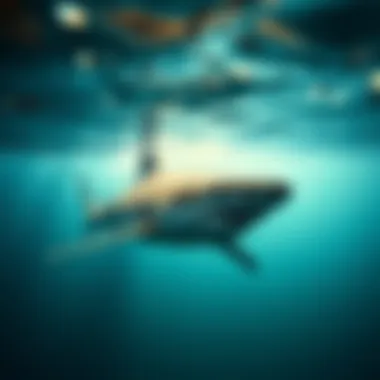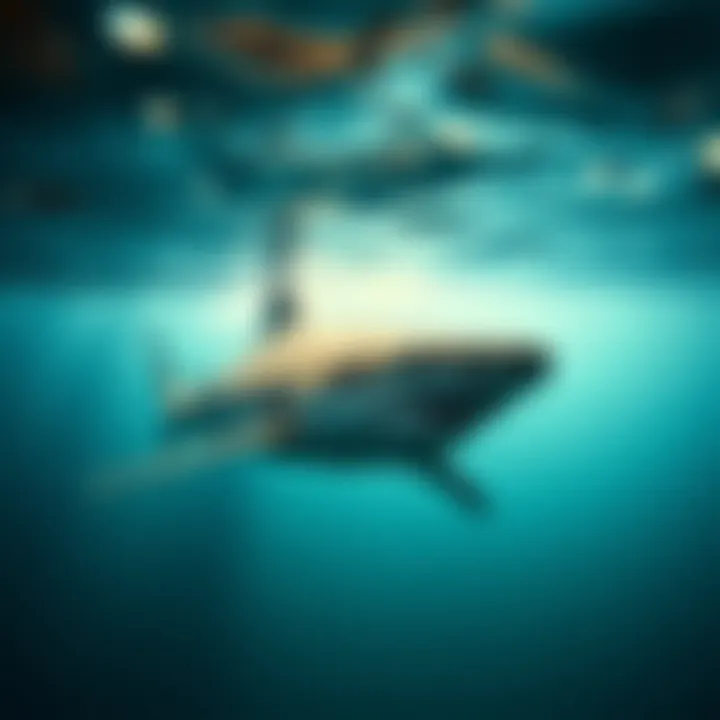Understanding Sharks: Exploring Their Fears


Intro
Sharks have long captured the human imagination, provoking fear and awe in equal measure. Despite their essential role in maintaining the balance of marine ecosystems, misunderstandings and myths surrounding these creatures have flourished. Whether it’s their portrayals in popular culture or our own experiences at the beach, the anxiety surrounding sharks influences public perception and conservation efforts.
Understanding the depths of these fears is critical—not just for addressing misconceptions, but also for protecting these apex predators. Sharks are not mindless killers; they are complex animals with unique behaviors and ecological importance. To grasp their fears, both real and perceived, we must dive deep into various factors influencing their behavior, including environmental changes, human interactions, and their role within the marine food web.
Factors Influencing Shark Behavior
Sharks display a range of responses to both natural threats and human presence. By examining their natural predation patterns and social interactions, we get a clearer picture of what drives their behaviors.
Ecological Factors
The health of marine habitats directly affects shark populations. Healthy reefs and coastal ecosystems provide them with food and safe breeding grounds. Conversely, habitat degradation from pollution, climate change, and overfishing can lead to displacement, altering their natural behaviors and potentially driving them closer to human activity.
"Sharks' movements and activities reflect not just their biology but the very health of the ocean itself."
Behavioral Patterns
Sharks, like any other wildlife, exhibit behaviors influenced by instinct, learned experiences, and environmental stimuli. For instance, a shark that encounters fishing nets may develop a wariness toward boats, impacting their migration routes. Furthermore, social hierarchies among different species can dictate interactions, both aggressive and benign, with their surroundings.
Human Impact on Sharks
The influence of human activity on shark behavior cannot be understated. Overfishing and bycatch have serious consequences, not only for shark populations but for entire marine ecosystems. As humans encroach on ocean habitats, sharks find themselves navigating a world increasingly filled with obstacles, altering their typical patterns of behavior.
Ending
In this exploration, we will highlight how understanding the realities of shark fears reveals critical insights into their role in the ocean and emphasizes the need for informed conservation efforts. The more we learn about these creatures, the better equipped we become to safeguard them and the ecosystems they inhabit.
Biological Responses in Sharks
Delving into the biological responses in sharks offers a vital avenue for understanding their behaviors and interactions with their environment. These responses fundamentally shape how sharks react to various stimuli, providing essential insights for marine biologists and conservationists alike.
Sharks have existed for over 400 million years, adapting their instincts and biological make-up to survive in a constantly changing marine landscape. Understanding these biological responses not only informs us of how these creatures perceive threats but also highlights their role in the ocean's ecosystem, crucial for maintaining balance in marine life.
The Role of Instincts
Instincts are inherent components of a shark’s behavior. These instincts guide actions that are vital for survival—like hunting, mating, and avoiding peril. For instance, a great white shark, upon sensing the vibrations of a potential prey in the water, can initiate a swift predatory response driven by instinct rather than learned behaviors. This instinctual drive is hardwired, ensuring that sharks can react to threats or opportunities even in the absence of prior experience.
Sharks possess highly developed sensory systems that augment their instinctive behaviors.
- Lateral Line System: This unique organ helps sharks detect movements and vibrations in the water, allowing them to sense nearby prey or potential predators.
- Electroreception: Specialized cells called ampullae of Lorenzini enable sharks to detect electrical fields generated by other marine life. This ability plays an integral role when hunting in dark or murky waters.
These instinct-driven responses are crucial for their survival. However, they also make sharks formidable predators in the ocean.
Neurological Mechanisms
The neurological machinery behind a shark's behavior is intricate and indispensable for understanding their reactions to environmental factors. Sharks’ brains, though not large compared to their body size, are highly evolved with specialized regions that process sensory information rapidly. This efficiency in neurological processing strikes a balance between instinct and neurological feedback that allows sharks to react without overthinking.
Recent studies indicate that certain neuronal circuits are more active when sharks encounter stressors, enhancing their survival mechanisms. This responsiveness can lead to quick adaptations.
- Safety Perception: A shark might detect changes in water pressure or temperature, triggering a fight-or-flight response. This mechanism signifies the balance between impulsive reactions and calculated decisions.
- Learning Capability: While instinct plays a significant part, there’s evidence that sharks can learn from their interactions within the ecosystem. They can adapt their hunting strategies based on past experiences, which showcases a blend of instinctual and neural processes at work.
"Understanding these neurological mechanisms is essential for appreciating how sharks maintain their status as apex predators in the ocean."
The robust interplay between instincts and neurological responses highlights the complexity of shark behavior. As we further unravel these biological responses, we gain a profound appreciation for these creatures, which are often mischaracterized due to a lack of understanding. Recognizing that sharks are not mindless killers but rather highly evolved animals adapting to their environment in sophisticated manners emphasizes the need for their conservation.
Predation and Competition
Understanding how sharks navigate their roles in the ecosystem is crucial, particularly when it comes to their behaviors related to predation and competition. Sharks are apex predators, meaning they sit at the top of the food chain and help maintain the ecological balance of their marine environments. In this section, we delve into the dynamics of sharks as predators, the various competitors they face both within their species and outside, and the implications of these interactions on their survival and behavior.
Natural Predators
While sharks are often viewed as the kings of the ocean, they themselves are not exempt from predation. Killer whales, or orcas, pose one of the most significant threats to certain shark species. These highly intelligent mammals have been known to hunt and attack sharks, sometimes targeting larger species like the great white. This predation dynamic complicates the perception of sharks as invincible creatures of the sea.
Moreover, juvenile sharks are especially vulnerable to a variety of predators. Larger fish, including other sharks, can pose a threat to young sharks until they reach a size that makes them less appealing to these predators. The survival of juveniles is crucial for maintaining healthy shark populations, emphasizing the difference in predation risk they experience compared to adults.
"In the intricate web of the ocean, even the king can fall prey to another species, reminding us how interconnected these ecosystems are."


The role of natural predators extends beyond mere survival; it shapes behavioral adaptations in sharks. For instance, certain species may actively avoid known predator areas, developing migratory patterns that help them evade threats. This highlights the influence predators exert on the movement and habits of sharks, rather than solely being creatures that assert dominance in their surroundings.
Intraspecies Competition
It’s not just external threats that sharks must contend with; competition exists even among their own kind. Sharks are territorial creatures, and this territoriality can lead to conflict within species. Social structures, such as hierarchies based on size and age, often influence access to food and breeding partners. For example, larger males may monopolize access to females during mating seasons, leaving smaller males scrambling for opportunities.
Additionally, competition for food can spark intense interactions among sharks. In an environment rich with prey but limited resources, sharks may exhibit aggressive behaviors towards one another. They often display formidable tactics, like circling and sudden lunges, as they vie for the same meal. The abundance or scarcity of food sources directly affects these interactions and can influence shark populations in a given area.
In essence, understanding the nuances of intraspecies competition provides valuable insights into the social behaviors of sharks. Behavioral adaptations, such as hunting in packs or establishing feeding hierarchies, can be beneficial in ensuring survival.
Sharks, in their pursuit of sustenance and reproductive success, have honed their instincts and competitive strategies, showcasing their remarkable ability to adapt and thrive amidst challenges—both from predators and fellow sharks.
By examining both predation and competition, we can appreciate the intricate dance of survival among these complex creatures. Examining their roles not only enriches our understanding of them but also sheds light on the delicate balance of ocean ecosystems.
Environmental Threats
Understanding environmental threats is crucial to grasping the dynamics of shark behavior and survival. Various factors deteriorate their habitats, altering their natural inclination to thrive in diverse marine environments. Sharks play an essential role as apex predators, and any disturbance in their habitats can yield ripple effects throughout the oceanic ecosystem. The health of shark populations often reflects the condition of marine environments at large, making it imperative to evaluate how these threats impact them.
Habitat Degradation
Habitat degradation is perhaps one of the most pressing issues sharks face today. Coastal development, overfishing, and destructive fishing practices erode essential marine habitats such as coral reefs and mangroves. This loss of habitat disrupts the delicate ecosystems that sharks rely on for breeding and feeding. For instance, in areas where mangroves are destroyed, juvenile sharks lose vital nursery habitats essential for their growth and survival.
Consider the following aspects of habitat degradation:
- Coral Reefs: These structures are often referred to as the "rainforests of the sea" due to their rich biodiversity. Reef deconstruction leads to diminished fish populations, affecting sharks that rely on these fish as primary food sources.
- Coastal Development: Growth in urban coastal areas often leads to pollution and increased sedimentation, further diminishing the quality of marine life.
It's important for both conservationists and coastal planners to recognize that preserving these habitats will not only benefit sharks but entire marine ecosystems.
Climate Change Impacts
Climate change also poses significant challenges to sharks and their habitats. Rising ocean temperatures and ocean acidification alter the delicate balance in which sharks, along with countless marine species, thrive. Increased temperatures can shift the distribution of prey species, forcing sharks to adapt by traveling further, potentially encountering more fishing vessels or other human activities.
Moreover, when oceans become more acidic due to increased carbon dioxide absorption, essential ecosystems like coral reefs face severe threats. The bleaching of coral reefs compromises not just reef inhabitants, but also the sharks that hunt around these ecosystems:
- Temperature Shifts: Warmer waters can lead sharks to migrate toward cooler regions, impacting their traditional feeding grounds and breeding sites.
- Acidification Effects: Changing pH levels can impact fish populations, altering food webs and further complicating sharks' hunting behaviors.
This compound impact stresses the urgency of understanding climate change, not just as an environmental risk, but as a crucial element in shark population dynamics and distribution.
Pollution and Contaminants
Pollution is a multifaceted issue that directly affects the lives of sharks. Oceans are the final resting place for countless pollutants, from plastic debris to heavy metals and chemical runoff. These contaminants pose health risks to sharks, impairing their reproductive systems and overall physiology.
Sharks are often at the top of the food chain; hence, their bodies accumulate toxins from the marine environment through a process known as biomagnification. Consider the following points:
- Microplastics: These tiny pieces of plastic not only affect the marine food web but can also be ingested by sharks, leading to internal health complications.
- Heavy Metals: Accumulated in their tissues, metals like mercury can affect their neurological function, which in turn may compromise their predatory skills.
Overall, addressing pollution is critical; if we neglect these environmental threats, we stand to lose much more than just the sharks. Maintaining healthy, unpolluted oceans is essential not just for sharks, but for everyone who depends on the ocean's resources.
"The ocean is a fragile world full of wonders, and its well-being is tied to our own."
For additional information on shark habitats and ecosystem conservation, visit NOAA Fisheries and Ocean Conservancy.
Human Interaction
The interplay between humans and sharks adds layers of complexity to the understanding of sharks’ fears and behaviors. This section emphasizes how human activities shape shark populations, their behaviors, and the wider marine ecosystem. Sharks have lived in the oceans for millions of years, adapting to environmental changes and navigating natural predation pressures. Yet, since the advent of industrialization, human actions have drastically altered their oceans—often to the detriment of these apex predators.
Shark populations are increasingly vulnerable due to overfishing, habitat destruction, and pollution. Understanding these interactions not only sheds light on sharks but also highlights our role in maintaining oceanic health. Acknowledging our impact is crucial, especially for outdoor enthusiasts and surfers who cherish the ocean and its diverse inhabitants.
Fisheries and Hunting
Fisheries play a significant role in the dynamics between humans and sharks. Over the last few decades, commercial fishing has grown exponentially, leading to alarming declines in shark populations. Commercial fishing nets are notorious for catching sharks unintentionally, a practice known as bycatch. In many places, regulatory measures have not kept pace with the demand for shark products, resulting in unsustainable practices.
Shark meat, which is often considered a delicacy in various cultures, drives commercial hunting. Countries like Indonesia and Spain have robust markets for shark products, perpetuating hunting practices that threaten shark populations. Moreover, the practice of finning, where a shark's fins are cut off before it is thrown back into the water, is particularly gruesome. It leaves these creatures vulnerable and often leads to their death.
The consequences of such practices are not limited to the sharks alone. Reduced shark numbers can disrupt marine ecosystems, as these predators play vital roles in regulating the populations of prey species. When sharks vanish, that imbalance can cascade, leading to an overall decline in ocean health.
Key Points on Fisheries:


- Bycatch: Millions of sharks die each year due to unintentional captures in fishing gear.
- Demand for Shark Products: Cultural cuisines continue to promote the hunting of sharks, aggravating population declines.
- Ecosystem Impact: Overfishing leads to an imbalance in marine life, emphasizing the need for sustainable practices.
Shark Culling Practices
Shark culling represents a controversial response to public perception of danger posed by sharks. When shark attacks on humans occur, local governments sometimes resort to culling, which involves killing sharks in the affected areas. Proponents argue that this practice enhances safety for beachgoers. However, such measures often ignore the ecological reality that sharks rarely pose serious threats.
The practice of culling can lead to a false sense of security. The underlying issue of understanding shark behavior and enhancing safety through better education and awareness often gets overshadowed by immediate, reactive measures. Moreover, studies have shown that culling may actually increase the presence of less-healthy shark species, exacerbating the existing ecological issues rather than resolving them.
"Culling sharks not only fails to effectively improve human safety, it can also disrupt the natural balance of marine ecosystems."
As the conversation around shark conservation grows, it's become clear that culling should not be the default solution. Emphasizing coexistence and understanding sharks' vital role in the marine food chain could foster a more respectful relationship between humans and these fascinating creatures.
In summary, the methods of fishing and hunting, along with culling practices, create a complex web of interactions that influence both shark populations and human perceptions. It begs us to reconsider how we approach shark conservation and engage with oceanic ecosystems, especially for those who seek adventure and connection to the sea.
Social Dynamics Among Sharks
Understanding social dynamics among sharks is vital for comprehending their behavior and ecological roles. Sharks are often viewed as solitary predators, lurking the depths in search of fish. However, research reveals a more intricate tapestry of interpersonal interactions. These dynamics influence not just individual behavior but also the health of marine ecosystems overall. This section delves into the nuances of social interactions in sharks, emphasizing two critical aspects: schooling behavior and territorialism.
Schooling Behavior
Sharks may not be the first animals that come to mind when one thinks about schooling fish. Yet, certain species do exhibit coordinated behaviors that suggest a form of social interaction. The schooling behavior can occasionally be seen among species like the blacktip reef shark or the hammerhead. This is not merely about moving together; it involves communication, shared spatial awareness, and even cooperation when hunting.
When sharks school, they benefit from increased safety in numbers. Predators often target isolated or weaker individuals. By lingering in more considerable groups, these sharks can reduce their personal risk. There is also evidence that this behavior helps with foraging efficiency. When hunting smaller fish, a group of sharks can herd school prey into tighter formations, making it easier to capture food.
Considerations include:
- Predator Awareness: Being in a group can dissuade potential attackers.
- Hunting Success: Cooperative behavior can maximize food intake.
- Social Learning: Younger sharks may learn hunting tactics and navigation skills by observing older sharks.
Territorialism
Territoriality in sharks is another captivating aspect of their social dynamics. Although many species operate within a broader range, certain types are known to defend specific areas, particularly during mating season. This behavior can help safeguard vital breeding grounds and food resources — a strategy finely tuned by evolution.
Factors influencing territorialism include:
- Species Variation: Some sharks, like the great white, have more pronounced territorial behaviors than others.
- Resource Availability: Territories are often established where there is a consistent presence of prey.
"The establishment and defense of territory can lead to aggressive encounters, highlighting the need for understanding intra-species communication."
Territorial conflicts can arise, leading to aggressive displays. However, these encounters also underpin hierarchy and social structure within shark populations. Understanding territorialism can provide insights into how sharks manage their relationships and resources within their habitats.
By exploring these social dynamics, one can appreciate the complexity of shark behavior beyond their predatory image. It emphasizes the necessity of preserving their habitats and understanding their role in the broader ecosystem. For additional information, interesting insights can be found in community discussions on platforms like Reddit and research articles on sites like Britannica.
Navigating through the social waters of sharks is an enriching endeavor that can alter our perspectives on these majestic creatures. Indeed, sharks are not just enigmatic predators; they are also social beings whose interactions have significant implications for marine ecosystems.
Reactions to Alarming Signals
Understanding how sharks react to alarming signals is crucial in comprehending their behavior and the fears often associated with them. These reactions not only provide insight into their survival mechanisms but also unravel some of the foundational fears people harbor about these magnificent creatures. The way sharks perceive threats can be a blend of instinctual responses to both environmental changes and human-induced disturbances. Recognizing and understanding these signals allows for better conservation efforts and improved interactions between humans and sharks.
Sound Sensitivity
Sharks possess a profound sensitivity to sound, a trait that underscores their role as apex predators. They can pick up low-frequency sounds—a detail that may easily slip under the radar of many outdoor enthusiasts. This exceptional ability stems from a unique structure in their inner ear known as the otolith, which helps to amplify sound waves. What might seem like an innocuous splash to us can translate to something entirely different for a shark, potentially signaling the presence of prey or a rival.
In addition, studies have shown that certain sounds can act as alerts for sharks regarding their environment. For instance, skipping sounds of fish distress can lure sharks closer, while unusual noises from boats or machinery may incite caution. Notably, this sensitivity can also mean that during activities like fishing or water sports, individuals might unintentionally attract sharks more than they realize.
"Understanding sound sensitivity in sharks is key to why they react the way they do—it's less about aggression and more about instinctual survival."
Strategies that surfers and divers can implement include being mindful of sound when in waters known for sharks. Being inherently aware can help mitigate risks during aquatic adventures while sustaining respect for the ocean's balance.
Movement Detection
Another remarkable trait of sharks is their ability to detect movement within the water with uncanny precision. Their lateral line, a specialized organ running along their bodies, is attuned to vibrations and changes in pressure, allowing them to sense even the most subtle motions around them. This extraordinary skill helps them gauge the presence of prey, predators, or even competitors in their waters.
The implications of this ability can't be overstated. For example, when a surfer paddles through the water, even slight disturbances can signal sharks that something is amiss. Whether it's the fast flapping of a fish or the erratic movements of a swimmer, sharks rely heavily on these movement cues to decide whether to investigate further or swim away.
Numerous encounters have shown that sudden or erratic movements from humans might be misinterpreted as signs of distress. Thus, maintaining steady, calm movements can aid in avoiding unwanted attention. This is particularly important during dusk or dawn when visibility is low, and sharks may rely more on their other senses to identify potential threats.
With the ocean being a realm of both beauty and peril, becoming familiar with how sharks react to alarming signals can foster a deeper understanding and respect, ultimately leading to safer interactions and better preservation of these incredible animals.


Cultural Perceptions and Misconceptions
Understanding how sharks are viewed in different cultures is crucial for grasping the fears and misunderstandings surrounding these creatures. Misconceptions perpetuated by fear or sensational media can dictate how people think about, and ultimately treat, sharks. By investigating the narratives shaped around sharks, one gains insight into the broader implications for conservation efforts and biodiversity.
Media Representations
Media plays a hefty role in framing perceptions of sharks. From movies like "Jaws" to various documentaries, the portrayal of sharks often leans towards the dramatic and exaggerated. These representations generally conjure images of ferocity and menace, overshadowing the reality of shark behavior and their ecological importance.
For example, consider how "Shark Week" on Discovery Channel showcases both the thrilling and terrifying aspects of sharks. While it can increase awareness about these apex predators, it often fails to balance the presentation with accurate information about their behavior and conservation status. Such selective highlighting can lead to what behavioral scientists call "fear conditioning", where individuals develop an aversion towards an animal based largely on fear.
"If everyone believed everything they saw on TV, we'd all think sharks were plotting world domination."
It's important to dissect these media narratives, as they can impact public opinion and the policies that arise from them. Understanding how stories about sharks are marketed can lead to more informed views and contribute to changes in media production toward a more educational aim.
Myth-Busting Shark Fears
Sharks, like any other creature, are often subject to myths that conflate facts and fiction. One common myth is that sharks are relentless man-eaters. In reality, most species are more interested in swimming peacefully and are not a threat to humans. Additionally, statistics show that shark attacks are exceedingly rare. For example, you are more likely to get struck by lightning than bitten by a shark.
Another misconception is that all sharks are aggressive. This is far from the truth; many species are docile, such as the whale shark, which is harmless and primarily consumes plankton. Furthermore, "shark culling," often proposed as a solution to fear of shark attacks, disrupts local ecosystems and can lead to imbalances that could make the situation worse.
In combating these misconceptions, it becomes necessary to promote factual information. Here are several key points to emphasize in conversations about shark fears:
- Sharks play a vital role in maintaining marine ecosystems.
- Shark attacks on humans are rare. Most encounters do not result in bites.
- Conservation is critical. Preserving shark populations helps to protect ocean health.
Addressing these myths is vital, not just for the sharks’ sake but also for our own understanding of marine environments. When folks have a more accurate picture of shark behavior and ecology, it breaks down walls of fear and creates room for a collaborative approach to conservation. Educational programs and community workshops can be pivotal in changing perceptions toward a more respectful view of these remarkable animals.
Sharks and Ecosystem Balance
The discussion surrounding sharks often skews toward their fearsome reputation. However, it’s essential to recognize their role within the larger ecological tapestry of marine environments. Sharks are not merely predators lurking in the depths; they serve a purpose vital to maintaining oceanic health. By understanding this balance, we can better appreciate these creatures and the ecosystems they inhabit.
Role as Apex Predators
Sharks sit atop the food chain as apex predators, which places them in a unique position within marine ecosystems. Their primary function involves regulating species populations below them, such as fish and other marine life. This regulation promotes a balanced ecosystem, ensuring that no single species dominates the ocean. For instance, studies have shown that removing sharks from an environment can lead to a surge in the numbers of smaller predatory fish. This, in turn, negatively affects the population of herbivorous species, creating an imbalance that can disrupt coral reefs.
Sharks don’t just hunt indiscriminately; they target weak and sick animals, contributing to the health of prey populations. This natural selection enhances genetic diversity and resilience within species. In various coastal regions, local fishers have noted that healthy shark populations correlate with robust fisheries. In short, by managing prey species, sharks enable a smoother flow in the entire food web, ensuring stability.
Impact on Ocean Health
The impact of sharks extends beyond individual populations; their mere presence can foster healthier ecosystems overall. Healthy shark populations lead to a balanced distribution of marine life, which consequently aids in the preservation of underwater habitats like coral reefs, mangroves, and seagrass beds. These environments often serve as crucial breeding grounds for a multitude of species.
- Coral Reefs: Sharks help maintain populations of insects and fish that feed on coral algae. Without sharks, these grazers could overpopulate and lead to algal blooms that suffocate coral.
- Mangroves and Seagrasses: These areas act like nurseries for young fish, and thanks to sharks, their stability is maintained. A balanced ecosystem fosters biodiversity, allowing for healthy nutrient cycling.
In a nutshell, when shark populations dwindle, the repercussions ripple through the food chain, adversely affecting countless marine species and the services they provide for humans. Protecting sharks is not just an environmental issue; it’s a necessity for sustaining global food security as well.
"The conservation of sharks translates directly into the health of our oceans."
Initiatives focused on preserving these apex predators not only safeguard ocean health but also contribute to resilience against climate change. Whether it’s through community-based efforts or legislative protection, recognizing the importance of sharks in our oceans is crucial for future sustainability.
For more insights into this topic, consider visiting:
Wikipedia on Sharks
Britannica on Marine Ecosystems
NOAA's Resources on Shark Conservation
National Geographic Ocean Health
Future of Shark Conservation
The future of shark conservation is a topic that embodies the confluence of ecological awareness, marine biodiversity, and human responsibility. As we continue to explore our oceans, recognizing the pivotal role sharks play within marine ecosystems becomes ever more critical. Not only are they apex predators contributing to the health of marine environments, but they also symbolize broader issues related to ocean life conservation. A well-rounded approach to their conservation not only aids in safeguarding these creatures but also ensures a balanced and robust ecosystem.
Legislative Efforts
Legislative frameworks form the backbone of effective shark conservation strategies. Governments around the world have started to realize the fragility of shark populations and the significant threats they face from overfishing, habitat loss, and climate change. Key legislative actions can include:
- International Treaties: Agreements like the Convention on International Trade in Endangered Species (CITES) highlight the need for international cooperation in shark conservation. Many species are at risk of extinction, making these treaties imperative for their protection.
- Local Regulations: States and countries have begun implementing laws that restrict shark fishing and enhance protections against bycatch. For instance, some places now enforce seasonal fishing bans or restrict fishing in breeding grounds, allowing populations to recover.
- Awareness Campaigns: Legislative efforts also encompass programs aimed at educating the public on the importance of sharks. By driving public awareness, regulations can become more robust due to community support.
These efforts align with the pressing need to create sustainable fishing practices that protect both economic interests and marine biodiversity. Emerging laws and directives aim to balance human needs with the vital role sharks play in ocean ecosystems.
Community-Based Initiatives
Conservation won't just come from above; it must also percolate from grassroots efforts aimed at fostering local engagement. Community-based initiatives have shown promise in empowering local populations while promoting the protection of shark species. Such initiatives can take various forms:
- Local Stewardship Programs: Communities can play a significant role in ecosystem monitoring. When locals are educated and involved, they become advocates for marine sustainability, monitoring changes in shark populations and reporting illegal fishing activities.
- Eco-Tourism: Encouraging shark-related tourism can bring economic incentives while fostering a sense of pride and stewardship within communities. Places like the Bahamas and South Africa have found success in tour companies promoting cage diving or snorkeling experiences that benefit local economies while increasing awareness about sharks' roles.
- Collaborative Research: Partnerships between researchers and local fishers can lead to innovative conservation strategies. Fishermen often have invaluable knowledge regarding shark behavior and habitats, making their involvement critical in formulating adaptable and relevant conservation plans.
In summary, the future of shark conservation rests in a symbiotic relationship between legislation, community engagement, and informed public support. As the saying goes, "It takes a village to raise a child," and in this case, it takes a community to save our sharks. By merging top-down approaches with grassroots efforts, we can ensure a sustainable future for sharks and, by extension, our oceans.
"Sharks must be remembered not just as fearsome predators, but as vital helpers in maintaining the ocean's ecosystem."
For further readings and resources on shark conservation, visit Wikipedia or Britannica.
For specific details on international efforts, check out CITES.
Through these combined efforts, we can transition from fear to understanding, ensuring a sustainable coexistence with these majestic creatures.







